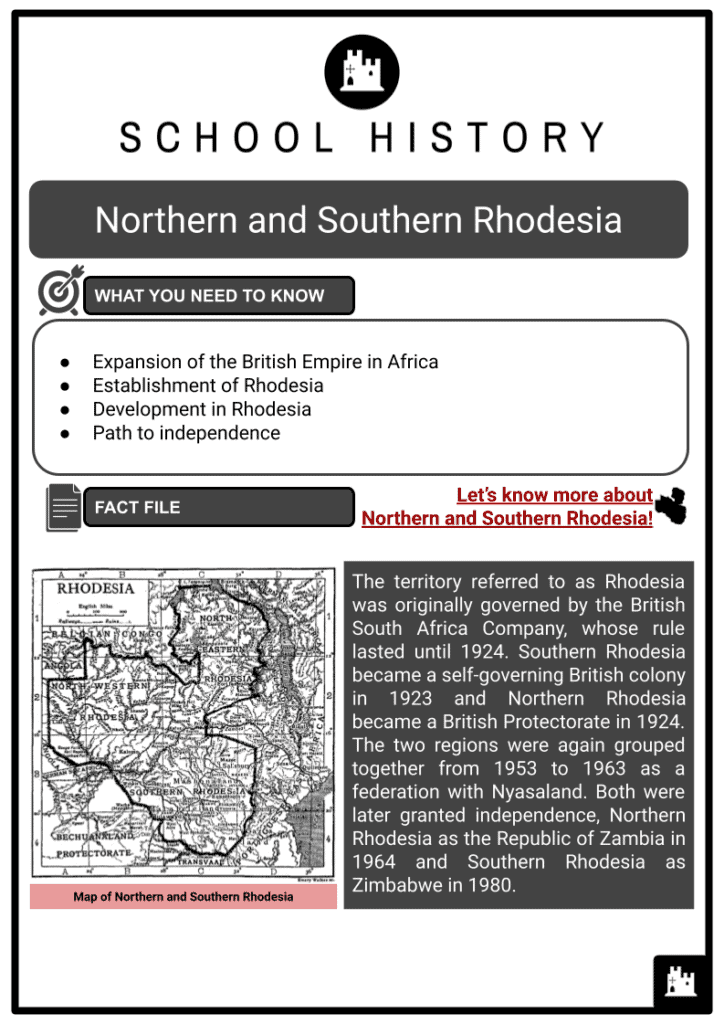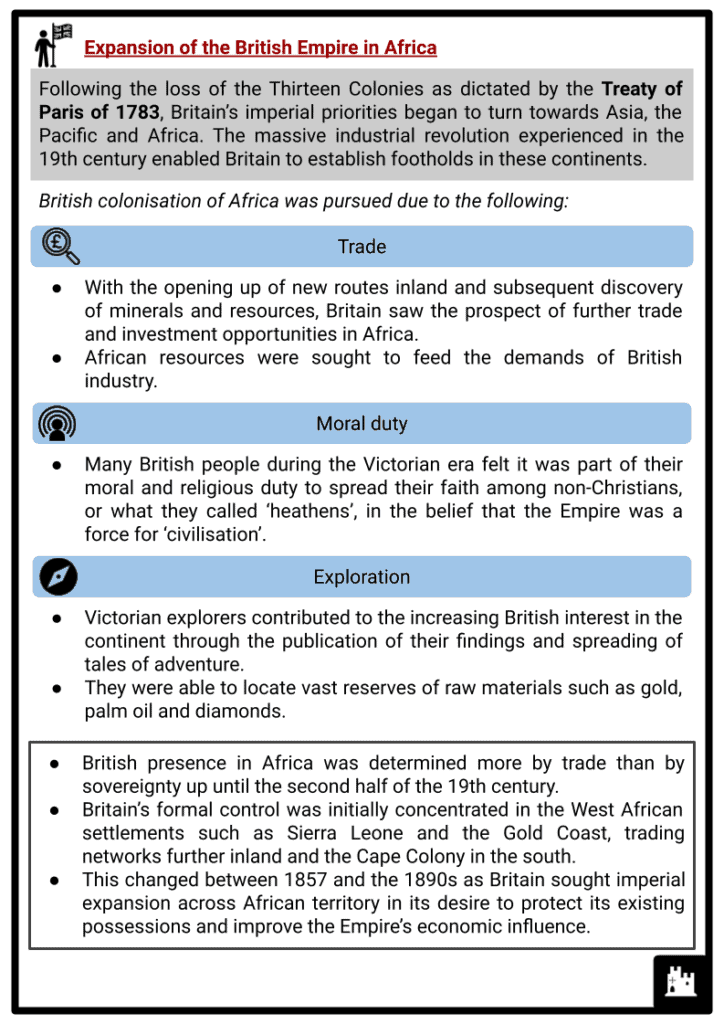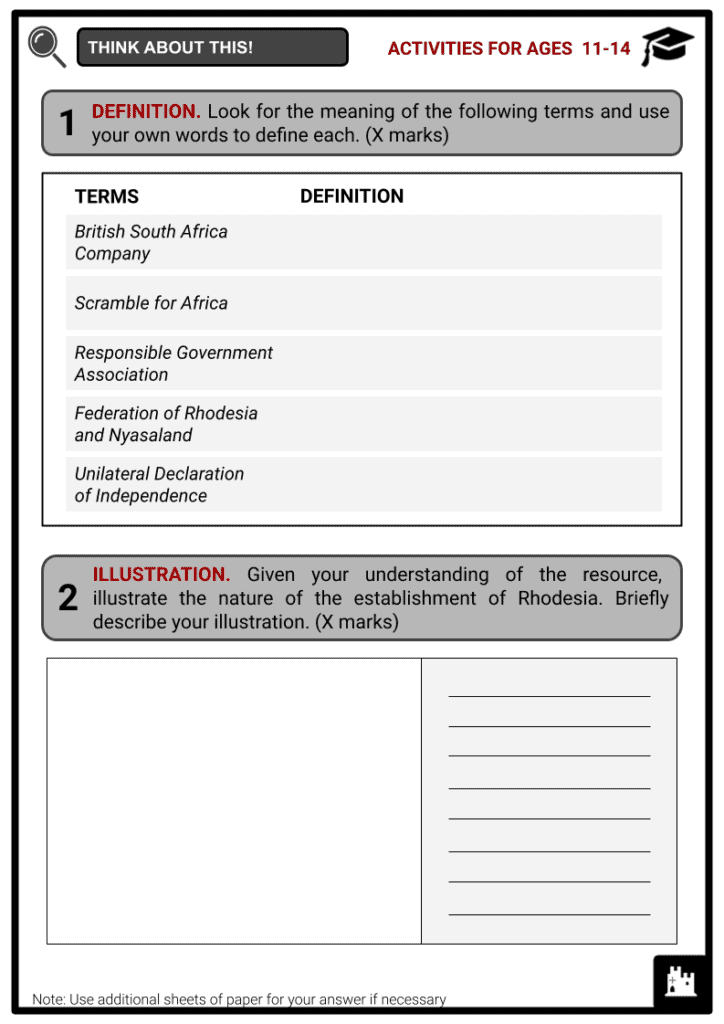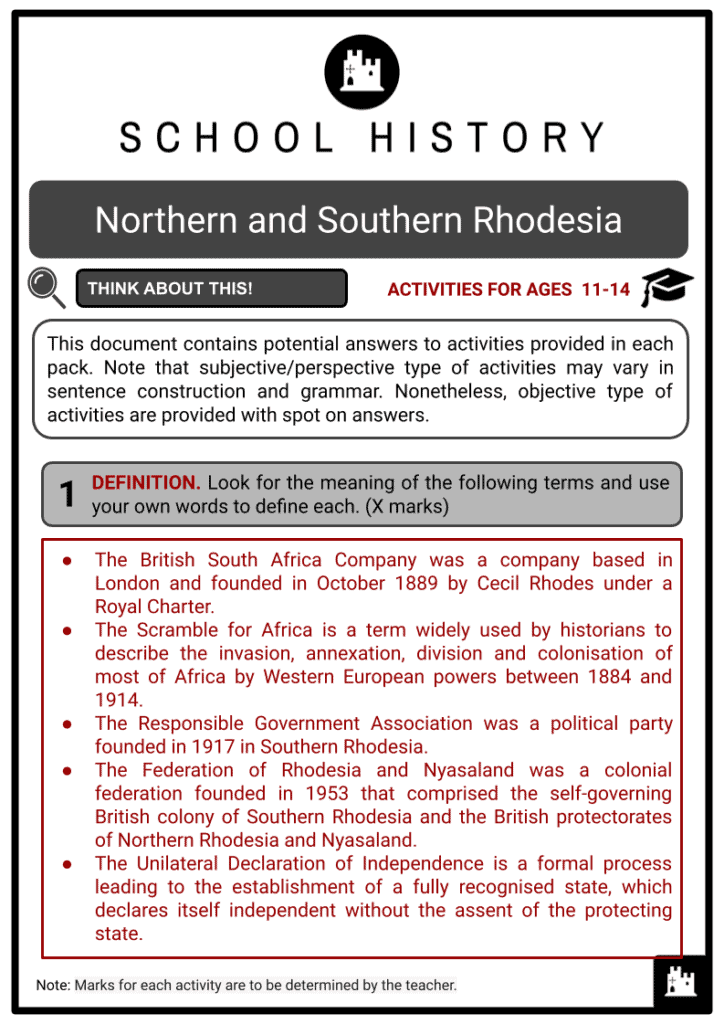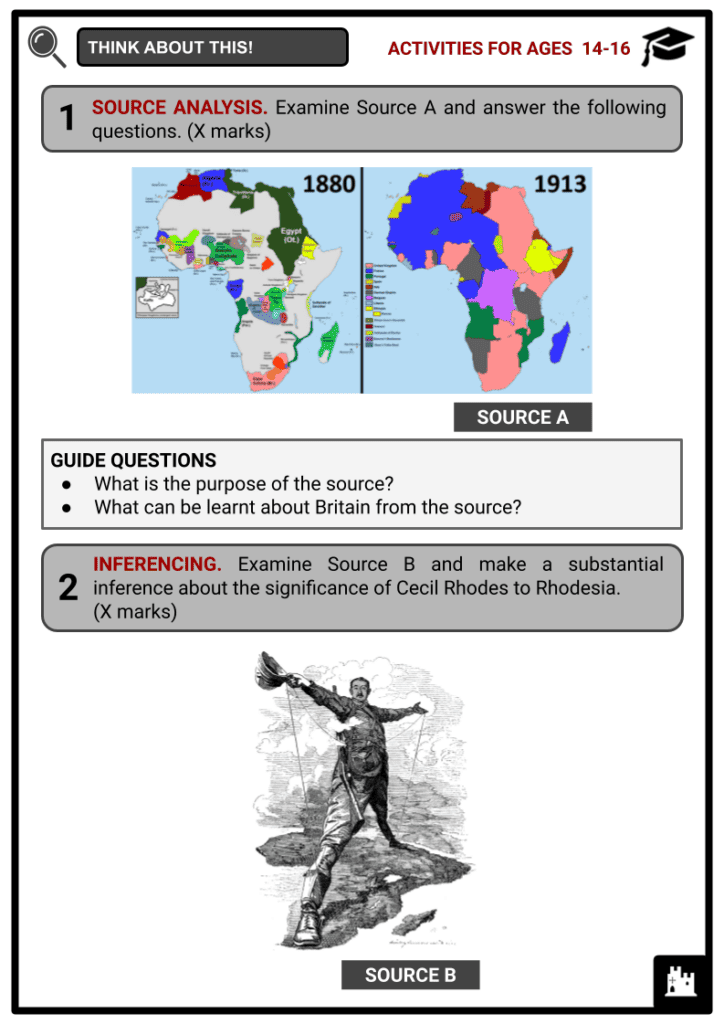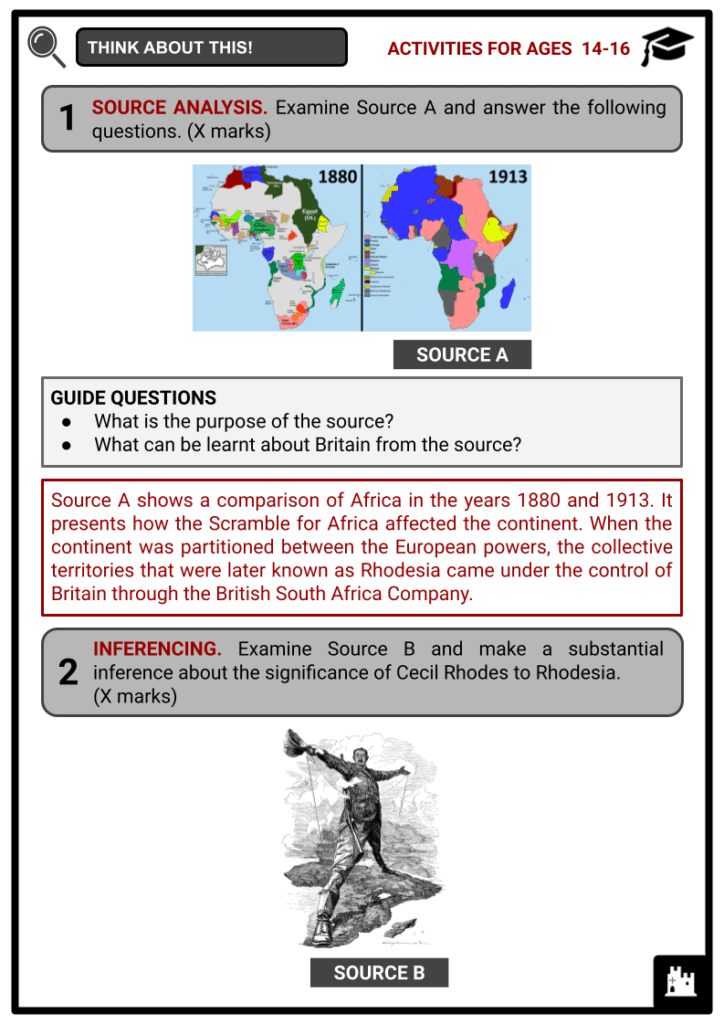Northern and Southern Rhodesia Worksheets
Do you want to save dozens of hours in time? Get your evenings and weekends back? Be able to teach about Northern and Southern Rhodesia to your students?
Our worksheet bundle includes a fact file and printable worksheets and student activities. Perfect for both the classroom and homeschooling!
Summary
- Expansion of the British Empire in Africa
- Establishment of Rhodesia
- Development in Rhodesia
- Path to independence
Key Facts And Information
Let’s know more about Northern and Southern Rhodesia!
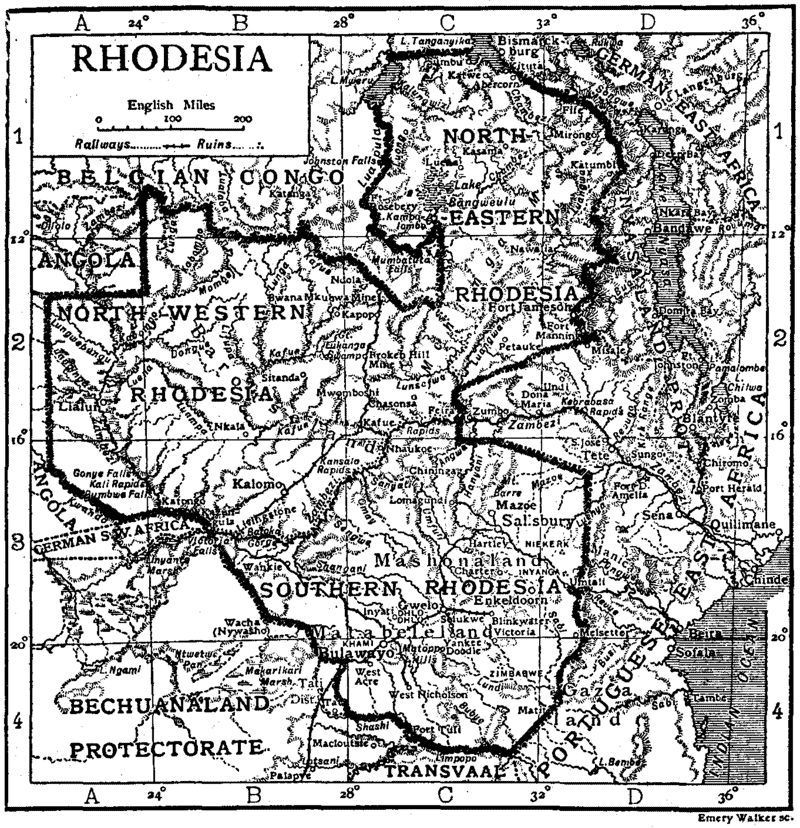
The territory referred to as Rhodesia was originally governed by the British South Africa Company, whose rule lasted until 1924. Southern Rhodesia became a self-governing British colony in 1923, and Northern Rhodesia became a British Protectorate in 1924. The two regions were again grouped together from 1953 to 1963 as a federation with Nyasaland. Both were later granted independence, Northern Rhodesia as the Republic of Zambia in 1964 and Southern Rhodesia as Zimbabwe in 1980.
Expansion of the British Empire in Africa
- Following the loss of the Thirteen Colonies as dictated by the Treaty of Paris of 1783, Britain’s imperial priorities began to turn towards Asia, the Pacific and Africa. The massive industrial revolution experienced in the 19th century enabled Britain to establish footholds on these continents.
- British colonisation of Africa was pursued due to the following:
- Trade
- With the opening up of new routes inland and subsequent discovery of minerals and resources, Britain saw the prospect of further trade and investment opportunities in Africa.
- African resources were sought to feed the demands of British industry.
- Moral duty
- Many British people during the Victorian era felt it was part of their moral and religious duty to spread their faith among non-Christians, or what they called ‘heathens’, in the belief that the Empire was a force for ‘civilisation’.
- Exploration
- Victorian explorers contributed to the increasing British interest in the continent through the publication of their findings and spreading of tales of adventure.
- They were able to locate vast reserves of raw materials such as gold, palm oil and diamonds.
- Trade
- British presence in Africa was determined more by trade than by sovereignty up until the second half of the 19th century.
- Britain’s formal control was initially concentrated in the West African settlements such as Sierra Leone and the Gold Coast, trading networks further inland and the Cape Colony in the south.
- This changed between 1857 and the 1890s as Britain sought imperial expansion across African territory in its desire to protect its existing possessions and improve the Empire’s economic influence.
British Expansion in Africa (1857–1890)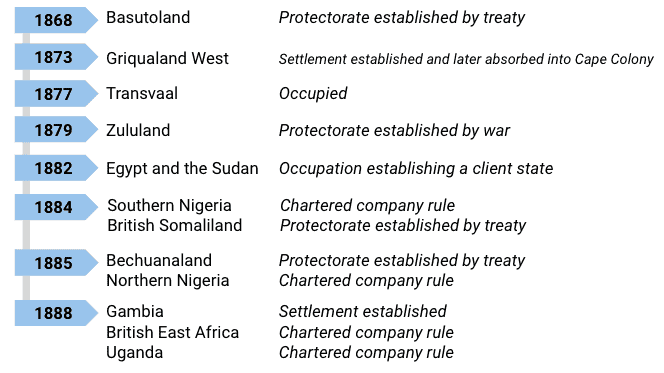
- Britain found a particular rival in France, which led to the formalisation of control of the former in areas where British traders had been operating. This was done by chartering companies, including the Royal Niger Company, the Imperial British East Africa Company and the British South Africa Company (BSAC) to enforce British claims in the continent.
Establishment of Rhodesia
- Amid the Scramble for Africa in the 1880s, the South African-based British capitalist and empire-builder, Cecil Rhodes envisaged the annexation of the southern and northern tips of Africa to the British Empire and the concurrent construction of a continuous railway line connecting the two regions.
- Rhodes’ vision was hampered by the presence of independent states to the north-east of Britain’s Cape Colony.
- Rhodes had already attempted and failed to secure a mining concession from Lobengula, King of the Ndebele of Matabeleland.
- In October 1888, he successfully obtained the Rudd Concession on exclusive mining rights in Matabeleland, Mashonaland and other adjoining territories from Lobengula.
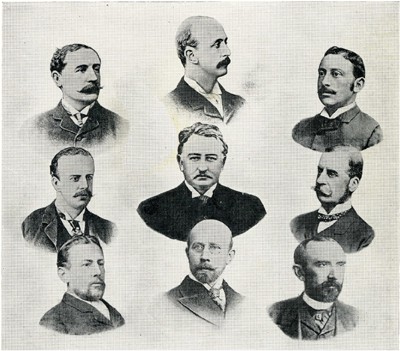
The first board of directors of the BSAC, 1889 - In October 1889, the BSAC, headed by Rhodes, was accorded a Royal Charter by Queen Victoria. This meant that the Company had the authority to trade with local rulers, set up banks, acquire and manage land, and assemble a police force.
- In exchange for these rights, the Company would administer and develop any territory it acquired, adhering to the laws established by extant African rulers and promoting free trade within its boundaries.
- Armed by a Royal Charter, Rhodes and the Company organised armed forces and carved out a vast tract of territory in the area north of the Transvaal in southern Africa through treaties, concessions and infrequent military action, particularly during the First and Second Matabele Wars of the 1890s.
- The concessions and treaties led to mass settlement, with the British holding control over labour and the Company exploiting the gold, copper and coal deposits in the region.
- The turn of the century saw the establishment of Rhodesia and the Company’s dominance over a huge, landlocked territory, bounded by the Zambezi River.
- Each territory acquired by the Company was initially referred to by its respective name, Mashonaland, Matabeleland and so on. With the lack of an official name, several terms were instead used for these collective territories, such as Zambesia and Charterland. The term ‘Rhodesia’ was used by the first European settlers in the region in the 1890s, who informally named their new home after Rhodes. The Company eventually adopted the name in 1895, and the British government followed suit three years later.
Development in Rhodesia
- In 1898, Matabeleland and Mashonaland, both of which lay south of the Zambezi, were formally referred to as Southern Rhodesia. They were officially united under that name in 1901. Meanwhile, the region to the north of the Zambezi became North-Western and North-Eastern Rhodesia, which were merged to form Northern Rhodesia in 1911. The administrative centres of the Company were in Salisbury in Southern Rhodesia, Fort Jameson in North-Eastern Rhodesia, and Kalomo in North-Western Rhodesia. The Company continued to govern Rhodesia for more than two decades as its Royal Charter was renewed for a further ten years in 1915.
Southern Rhodesia
- In 1899, a Legislative Council first sat in the region, which was comprised of the administrator himself, five members nominated by the Company, and four elected by registered voters. This later became a 20-member Legislative Council.
- Between the 1900s and early-1910s, white immigration to the region heightened. At the same time, farming and mining industries markedly improved.
- When the First World War broke out in 1914, the British in the region received the news enthusiastically and volunteered in huge numbers. Several travelled back to England and joined various British Army regiments, while others stayed at home and raised funds to donate food, equipment and other supplies.
- In 1917, the Responsible Government Association (RGA) was established. It aimed for self-government for Southern Rhodesia within the Empire and opposed the intended consolidation of the region into the Union of South Africa. On the contrary, the Company supported the region’s incorporation into South Africa. This prospect, however, grew largely unpopular.
- In 1920, the RGA won 10 of the 13 seats contested in the Legislative Council election. In 1922, a referendum on the region’s future was held and the majority voted for responsible government. In 1923, Southern Rhodesia was duly annexed by the Empire and soon became a self-governing British colony. The new government quickly arranged the purchase of the land from the British Treasury. Meanwhile, the Company continued to hold the mineral rights in the colony until 1933.
Northern Rhodesia
- The Company completely oversaw the administration of the region.
- White immigration to the region was limited, hence the white population was far smaller and mainly concentrated in the far west and in the vicinity of Fort Jameson near the eastern border. The lack of developed roads and railway lines made communication between the two white communities hard. The formal creation of Northern Rhodesia in 1911 failed to improve the situation.
- Immediately after the declaration of the First World War, Northern Rhodesian forces took part in fierce fighting against the German troops. Meanwhile, North-Eastern Rhodesia supplied around 56,000 African porters to move food and equipment during the conflict.
- In 1917, the five-member Advisory Council was set up.
- Following the non-renewal of the Company’s Royal Charter in 1923, the Company ceded control of the region to the British government but retained the territory’s mineral rights. In April 1924, the region became a Protectorate under the British Empire and a Legislative Council was subsequently formed, with the Governor acting as the presiding officer. Initially, the Council consisted entirely of nominated members since there was still no procedure for holding elections at the time. By this time, Company rule in the Rhodesias effectively ended.
- The 1920s saw the white European settlers in the Rhodesias seeking some form of a merger to thwart the dominance in population of Black Africans. The British Colonial Office prevented this in order to deter intense African opposition.
- When the Second World War ended, there had been development of secondary industries and considerable growth of white immigration in Southern Rhodesia, coupled with the copper boom in Northern Rhodesia.
- Such a situation saw the white political leaders and industrialists insisting even more of the economic benefits of a consolidated territory. As a consequence, the imperial government was convinced to back the proposed federation.
- In 1953, the self-governing British colony of Southern Rhodesia and the British protectorates of Northern Rhodesia and Nyasaland were grouped together to create the Federation of Rhodesia and Nyasaland, also known as the Central African Federation.
Path to independence
- The Federation persistently faced opposition from the Africans, especially in Northern Rhodesia and Nyasaland. Meanwhile, the economic advantages of the Federation were evident, with the gross domestic product steadily increasing. While the constitutional status of the three territories remained unchanged, policies in the Federation throughout the 1950s were observed to be benefiting the white population of the south to a great extent.
- African dissatisfaction further grew and finally came to a head in 1959, in which the expanding Nyasaland nationalist movement resulted in widespread unrest.
- The Federation’s government declared a state of emergency and the Southern Rhodesian forces were sent to bring order. Numerous nationalists were detained without trial.
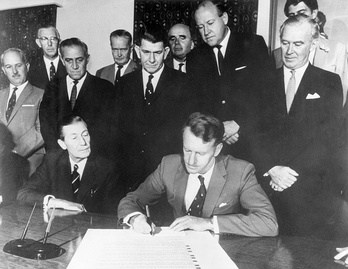
Signing of the Unilateral Declaration of Independence in Southern Rhodesia in November 1965 - These events drew the political viability of the Federation into question and ultimately persuaded the British government to officially dissolve the union in December 1963. Consequently, three separate divisions were formed.
- Additionally, pressure from both the United Nations (UN) and the Organisation of African Unity (OAU) proved important to British decolonisation in the continent.
- Shortly after the dissolution, the Nyasaland Protectorate became independent as Malawi in July 1964, with Hastings Banda as the first prime minister. This meant the effective end of the Federation.
- In October, Northern Rhodesia achieved independence as the Republic of Zambia, with Kenneth Kaunda as the first prime minister.
- Meanwhile, the white community in Southern Rhodesia issued a Unilateral Declaration of Independence as the Republic of Rhodesia in November 1965. This was a consequence of a prolonged dispute between the British and Rhodesian governments regarding the terms under which independence would be granted.
- The declaration led to outrage in Britain, but the British government decided not to re-establish control in the territory by force. The Republic of Rhodesia lasted until 1979.
- In June 1979, it became Zimbabwe Rhodesia as a result of the Internal Settlement between its prime minister and the moderate African nationalist leaders.
- In December 1979, Britain successfully took control of Zimbabwe Rhodesia as the Colony of Southern Rhodesia. In 1980, Britain formally granted independence to the colony as Zimbabwe, with Canaan Banana as the first head of state.
Frequently Asked Questions
- What were Northern and Southern Rhodesia?
Northern and Southern Rhodesia were British territories in southern Africa. Northern Rhodesia is modern-day Zambia, and Southern Rhodesia is present-day Zimbabwe.
- Why were they called Rhodesia?
They were named after Cecil Rhodes, a British businessman and politician who played a significant role in colonising these territories during the late 19th and early 20th centuries.
- What was the purpose of British colonisation in these territories?
The British established control for various reasons, including economic exploitation, access to resources such as minerals and agricultural products, and the desire to create a British-dominated African region.

